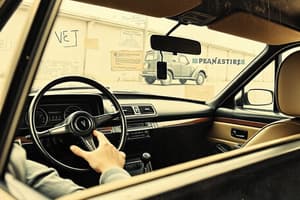Podcast
Questions and Answers
What should you look for when approaching the vehicle?
What should you look for when approaching the vehicle?
- Scratches
- Leaks (correct)
- Dents
- Tire Pressure
What should be checked about hoses?
What should be checked about hoses?
Hoses should be in good condition and not leaking.
What does the coolant sight glass indicate?
What does the coolant sight glass indicate?
It should have adequate fluid level.
What is the condition of the water pump supposed to be?
What is the condition of the water pump supposed to be?
What is the required state of the air compressor?
What is the required state of the air compressor?
What should be checked in the Power Steering fluid?
What should be checked in the Power Steering fluid?
What should the oil level be between?
What should the oil level be between?
What should alternators be checked for?
What should alternators be checked for?
What is a requirement for the entry door of the vehicle?
What is a requirement for the entry door of the vehicle?
What should be ensured about the seats in the vehicle?
What should be ensured about the seats in the vehicle?
The emergency exit windows must be clearly marked.
The emergency exit windows must be clearly marked.
What should be checked about the windshield?
What should be checked about the windshield?
How should the braking system function during the rolling service brake test?
How should the braking system function during the rolling service brake test?
What is the requirement for the rear drive tire tread depth?
What is the requirement for the rear drive tire tread depth?
Flashcards are hidden until you start studying
Study Notes
Vehicle Inspection Overview
- Conduct thorough inspections before operating the vehicle to ensure safety and compliance.
- Focus on all major components, both exterior and interior, during the pre-trip inspection.
Fluid Levels and Leaks
- Leaks: Look for fluid leaks under the engine before driving.
- Hoses: Ensure all hoses are intact, not leaking, and in good condition.
- Coolant: Verify adequate coolant levels using the sight glass.
- Power Steering Fluid: Check sight glass for fluid levels; remove cap if not visible.
- Oil Level: Confirm oil is between the add and full marks.
Engine and Powertrain Components
- Water Pump: Must be securely mounted, non-damaged, belt-driven, and leak-free.
- Air and Power Steering Pumps: Ensure they are gear-driven and securely mounted.
- Alternators: Should be belt-driven, securely mounted, without exposed wires, and no fraying on belts.
Safety Features and Door Integrity
- Entry Door: Check for damage, proper operation, and clear, uncracked glass.
- Emergency Exits: Ensure windows and hatches are clearly marked, functional, and not damaged.
- Fire Extinguisher: Must be securely mounted, easily accessible, and charged.
Seating and Accessibility
- Seats: Confirm all seats are securely mounted and functional.
- Hand Rails: Ensure all hand rails are securely attached for passenger safety.
- Entry Steps: Check that steps are free of debris and securely mounted.
Instrumentation and Controls
- Safe Start: Ensure the master switch is on, transmission is in neutral, and brakes are engaged before starting the engine.
- Oil and Temperature Gauges: Monitor for normal operating ranges upon starting.
- ABS System: Ensure the ABS warning light illuminates during startup and turns off.
Brake System Checks
- Park Brake Test: Apply service brake and check functionality between 120-125 PSI.
- Air Brake Check: Verify no more than 3 PSI loss in one minute at 120-125 PSI; check alarms at low pressure.
Lighting and Visibility
- Wipers and Washer Fluid: Ensure wipers are functioning and the washer fluid system operates effectively.
- Indicators and Headlights: Test all lights for functionality and clarity, ensuring they are not cracked.
Tires and Suspension
- Tires: Inspect for even wear, appropriate tread depth (no less than 4/32" for front tires and 2/32" for rear tires), and proper inflation.
- Rims: Check for secure mounting and integrity; no visible signs of failure such as rust trails.
- Suspension: Ensure components like the air ride suspension, shock absorbers, and brackets are not leaking or damaged.
Rear Components and Additional Features
- Rear Tire and Rim: Inspect rear tires for similar condition and check rim integrity.
- Emergency Triangles: Ensure three emergency triangles are present and accessible.
- Exhaust System: Confirm that there are no leaks or visible damage, ensuring safety from exhaust fumes.
Final Remarks
- Conduct each inspection methodically, ensuring no step is overlooked.
- Maintain a checklist for consistency and thoroughness during vehicle inspections.
Studying That Suits You
Use AI to generate personalized quizzes and flashcards to suit your learning preferences.




